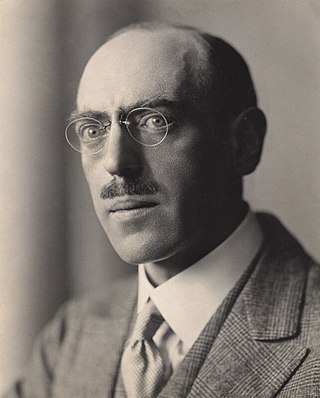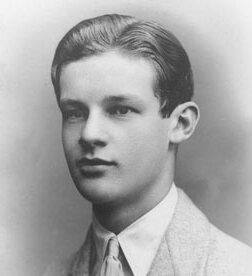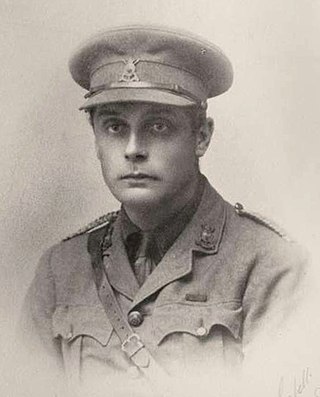
Alan Alexander Milne was an English writer best known for his books about the teddy bear Winnie-the-Pooh, as well as for children's poetry. Milne was primarily a playwright before the huge success of Winnie-the-Pooh overshadowed all his previous work. He served in both world wars, as a lieutenant in the Royal Warwickshire Regiment in the First World War and as a captain in the Home Guard in the Second World War.

Hector Hugh Munro, popularly known by his pen name Saki and also frequently as H. H. Munro, was a British writer whose witty, mischievous and sometimes macabre stories satirize Edwardian society and culture. He is considered by English teachers and scholars a master of the short story and is often compared to O. Henry and Dorothy Parker. Influenced by Oscar Wilde, Lewis Carroll and Rudyard Kipling, Munro himself influenced A. A. Milne, Noël Coward and P. G. Wodehouse.

Reginald Victor Jones was a British physicist and scientific military intelligence expert who played an important role in the defence of Britain in World War II by solving scientific and technical problems, and by the extensive use of deception throughout the war to confuse the Germans.

Tobermory is the capital of, and until 1973 the only burgh on, the Isle of Mull in the Scottish Inner Hebrides. It is located on the east coast of Mishnish, the most northerly part of the island, near the northern entrance of the Sound of Mull. The town was founded as a fishing port in 1788; its layout was based on the designs of Dumfriesshire engineer Thomas Telford. As of 2022 its population was 1,045. It is notable as the location for the 2002–05 children's programme Balamory by the BBC.

Robert Offley Ashburton Crewe-Milnes, 1st Marquess of Crewe,, known as The Honourable Robert Milnes from 1863 to 1885, The Lord Houghton from 1885 to 1895 and as The Earl of Crewe from 1895 to 1911, was a British Liberal politician, statesman and writer.

General Sir Hector Munro, 8th Laird of Novar, KB was a British Army officer and politician who sat in the British House of Commons representing the constituency of Inverness Burghs from 1768 to 1802.
"Sredni Vashtar" is a short story by Saki, written between 1900 and 1911 and first published in his 1911 short story collection The Chronicles of Clovis. It has been adapted for opera, film, radio and television.

Walter Lionel George was an English writer, chiefly known for his popular fiction, which included feminist, pacifist, and pro-labour themes.

(George) James Henry Lees-Milne was an English writer and expert on country houses, who worked for the National Trust from 1936 to 1973. He was an architectural historian, novelist and biographer. His extensive diaries remain in print.
Debi Gliori is a Scottish writer and illustrator of children's books.
When William Came: A Story of London Under the Hohenzollerns is a novel written by the British author Saki and published in November 1913. It is set several years in what was then the future, after a war between Germany and Great Britain in which the former won.
Beasts and Super-Beasts is a collection of short stories, written by Saki and first published in 1914. The title parodies that of George Bernard Shaw's Man and Superman.

"Bob's your uncle" is an idiom commonly used in the United Kingdom and Commonwealth countries that means "and there it is", or "and there you have it", or "it's done". Typically, someone says it to conclude a set of simple instructions or when a result is reached. The meaning is similar to that of the French expression "et voilà!".

Auberon Thomas Herbert, 9th Baron Lucas and 5th Lord Dingwall, PC, who preferred to be known as Bron Herbert, was a radical British Liberal politician and fighter pilot. He was a member of H. H. Asquith's cabinet as President of the Board of Agriculture and Fisheries between 1914 and 1915.

Arthur John Langguth was an American author, journalist and educator, born in Minneapolis, Minnesota. He was professor of the Annenberg School for Communications School of Journalism at the University of Southern California. Langguth was the author of several dark, satirical novels, a biography of the English short story master Saki, and lively histories of the Trail of Tears, the American Revolution, the War of 1812, Afro-Brazilian religion in Brazil and the United States, the Vietnam War, the political life of Julius Caesar and U.S. involvement with torture in Latin America. A graduate of Harvard College, Langguth was South East Asian correspondent and Saigon bureau chief for The New York Times during the Vietnam War, using the byline "Jack Langguth". He also wrote and reported for Look Magazine in Washington, DC and The Valley Times in Los Angeles, California. Langguth joined the journalism faculty at USC in 1976. He was awarded a Guggenheim Fellowship in 1976, and received the Freedom Forum Award, honoring the nation's top journalism educators, in 2001. He retired from active teaching at USC in 2003.

Charles Jamrach was a leading dealer in wildlife, birds and shells in 19th-century London. He owned an exotic pet store on the Ratcliffe Highway in east London – at the time the largest such shop in the world. Jamrach's nearest rival was Edward Cross, who ran a menagerie at Exeter Exchange on the Strand.

Tobermory Cat is the name of a celebrity ginger cat used as an "evolving, interactive artwork" by Scottish artist Angus Stewart.

Randal John Somerled McDonnell, 8th Earl of Antrim KBE (1911–1977) was a diplomat, activist, soldier and administrator. He became chairman of the National Trust in 1965.

"Tobermory" is a humorous short story by Hector Hugh Munro written under his pen-name, Saki. It was originally published in The Westminster Gazette in 1909, first collected, in a revised form, in The Chronicles of Clovis (1911), and has frequently been reprinted in anthologies.
















